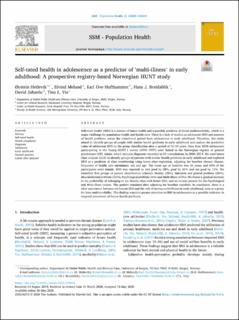Self-rated health in adolescence as a predictor of 'multi-illness' in early adulthood: A prospective registry-based Norwegian HUNT study.
Hetlevik, Øystein; Meland, Eivind; Hufthammer, Karl Ove; Breidablik, Hans Johan; Jahanlu, David; Vie, Tina Løkke
Journal article, Peer reviewed
Published version

Åpne
Permanent lenke
https://hdl.handle.net/11250/2739906Utgivelsesdato
2020-08Metadata
Vis full innførselSamlinger
Originalversjon
SSM - Population Health. 2020, 11 (August), 100604 https://doi.org/10.1016/j.ssmph.2020.100604Sammendrag
Self-rated health (SRH) is a marker of future health and a possible predictor of future multimorbidity, which is a major challenge for population health and health care. There is a lack of studies on adolescent SRH and patterns of health problems across the transitional period from adolescence to early adulthood. Therefore, this study aimed to identify groups of people with similar health problems in early adulthood and explore the predictive value of adolescent SRH on the group classification after a period of 10–19 years. Data from 8828 adolescents participating in the Young HUNT-1 survey (1995–1997) were linked to the Norwegian registry of general practitioner (GP) claims, which includes diagnoses recorded in GP consultations in 2006–2014. We used latent class analysis (LCA) to identify groups of patients with similar health problems in early adulthood and explored SRH as a predictor of class membership using latent class regression, adjusting for baseline chronic disease, frequency of health care attendance, sex and age. The mean age at baseline was 16 years, and 50% of the participants were female. SRH was reported as very good by 28%, good by 61% and not good by 11%. We identified five groups of patient classification (classes): Healthy (35%), Infections and general problems (26%), Musculoskeletal problems (21%), Psychological problems (6%) and Multi-illness (13%). We found a gradual increase in the probability of belonging to the Healthy class with better SRH, and an inverse pattern for the Psychological and Multi-illness classes. This pattern remained after adjusting for baseline variables. In conclusion, there is a clear association between adolescent SRH and the risk of having multi-illness in early adulthood, seen as a proxy for later multimorbidity. This finding warrants greater attention to SRH in adolescence as a possible indicator in targeted prevention of future health problems.
